Cucumber peels drive ants away fast because they contain compounds like cucurbitacin that disrupt ants’ pheromone trails, their primary navigation system. The strong scent masks these invisible highways, disorienting ants and preventing them from communicating food source locations to their colony. Fresh peels also release essential oils that can break down ants’ exoskeletons, causing dehydration. You’ll discover how to maximize this natural repellent’s effectiveness with proper placement and replacement techniques.
The Science Behind Cucumber’s Ant-Repelling Properties
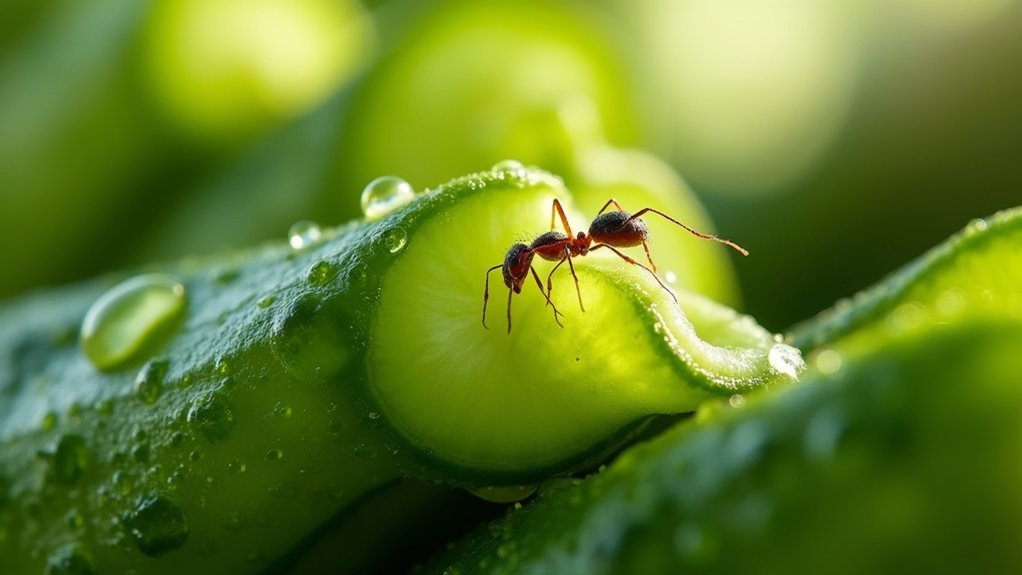
While many home remedies come and go, cucumber peels have earned their reputation as effective ant deterrents through genuine scientific mechanisms. When you place these peels around your home, you’re utilizing compounds like cucurbitacin that directly disrupt ants’ chemical communication systems.
The strong scent compounds in cucumber peels mask pheromone trails that ants depend on to navigate, fundamentally creating invisible roadblocks that confuse and redirect these insects.
Cucumber peels disrupt ant highways, masking their invisible trails and leaving the tiny explorers hopelessly lost.
What’s more impressive is how the essential oils in cucumbers can actually break down ants’ exoskeletons upon contact, leading to dehydration and death.
As a natural ant repellent, cucumber peels offer you an eco-friendly alternative to harsh chemicals, protecting your home while keeping your family and pets safe from potentially harmful pesticides.
How Cucumber Peels Disrupt Ant Pheromone Trails
As you place cucumber peels around your home, you’re interrupting the invisible highways that guide ant colonies. The cucumber peels release compounds like cucurbitacin that effectively mask and disrupt the pheromone trails ants depend on for navigation and communication.
When ants can’t detect their chemical signals, their organized foraging system breaks down. They become disoriented, unable to relay information about food sources to other colony members.
The bitter compounds in these peels create an environment that ants perceive as threatening, causing them to avoid treated areas altogether.
You’re fundamentally creating a natural repellent barrier without harsh chemicals. By strategically positioning cucumber peels at entry points and along common ant paths, you’ll confuse their communication system and redirect their activity away from your living spaces.
Step-by-Step Guide to Using Cucumber Peels for Ant Control
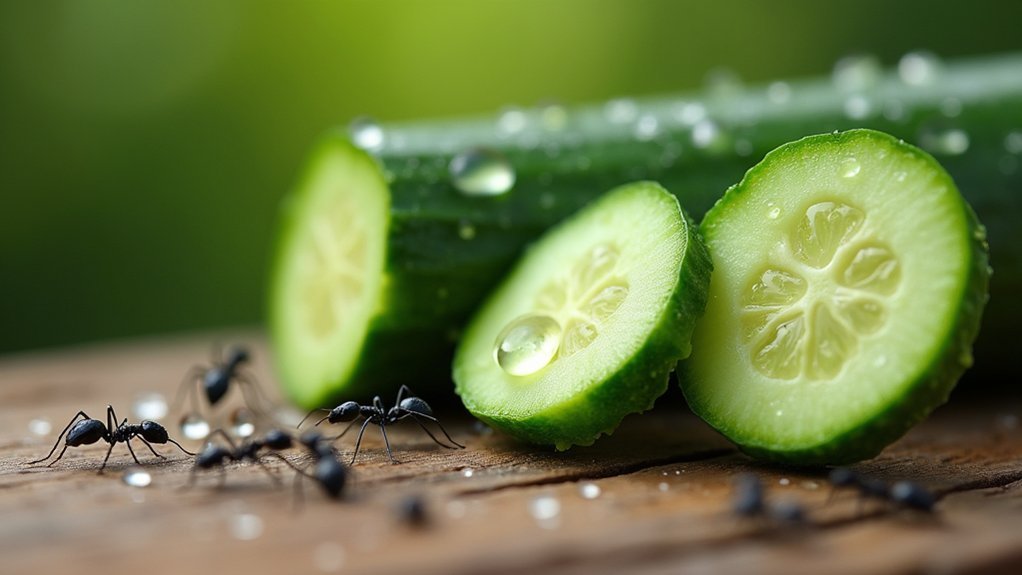
You’ll need to properly prepare your cucumber peels by cutting them into small strips or grating them to release their natural repellent compounds.
Place these fresh peels strategically around entry points, windowsills, and along visible ant trails where you’ve noticed ant activity.
Remember to replace your cucumber peels every 2-3 days as they dry out to maintain their effectiveness against persistent ant invasions.
Preparation and Cutting Techniques
Harvesting fresh cucumbers marks the first essential step in creating an effective ant repellent from peels. You’ll want to select cucumbers with firm, unblemished skin since these contain the highest concentration of compounds that repel ants.
Before preparation, thoroughly wash your cucumbers to remove any pesticides or residue. Then, using a sharp knife or vegetable peeler, slice thin strips from the cucumber’s exterior. Thinner peels release more scent and create a more effective natural barrier against ant invasions.
Cut the peels into sizes appropriate for your target entry points—longer strips work well along baseboards and windowsills, while smaller pieces fit perfectly in corners. Maximize the surface area by avoiding thick chunks, as this helps release the cucumber’s ant-repelling compounds more efficiently throughout your home.
Strategic Placement Locations
Four strategic locations exist for maximizing cucumber peels’ effectiveness against ant invasions.
First, place them along all entry points—doorways, windowsills, and cracks—to create a natural barrier that prevents ants from accessing your home.
Second, identify active ant trails and distribute cucumber peels directly along these paths to disrupt their pheromone communication systems.
Third, target suspected nest areas around your property’s perimeter by placing cucumber shavings nearby. The repellent properties will discourage colony expansion toward your home.
Fourth, focus on problem areas like kitchens and pantries where food attracts ants most frequently.
Remember to replace your cucumber peels every 2-3 days to maintain their potency.
For enhanced protection, consider combining them with other natural deterrents in high-traffic ant zones.
Maintenance and Replacement
Once you’ve strategically positioned cucumber peels throughout your home, maintaining their effectiveness becomes the next priority. Cucumber peels lose their repellent properties as they dry out or decompose, requiring regular attention to keep ants at bay.
Follow these steps for ideal results:
- Replace cucumber peels every 2-3 days to maintain their potent scent that ants avoid.
- Clean surfaces thoroughly before placing fresh peels to remove any food residue that might attract ants.
- Monitor ant activity around the peels to gauge effectiveness and adjust placement as needed.
- During peak ant seasons (typically spring and summer), check and refresh peels more frequently.
Combining your cucumber peel strategy with other natural deterrents like coffee grounds or essential oils creates a thorough defense system against persistent ant invasions.
Best Placement Locations for Maximum Effectiveness
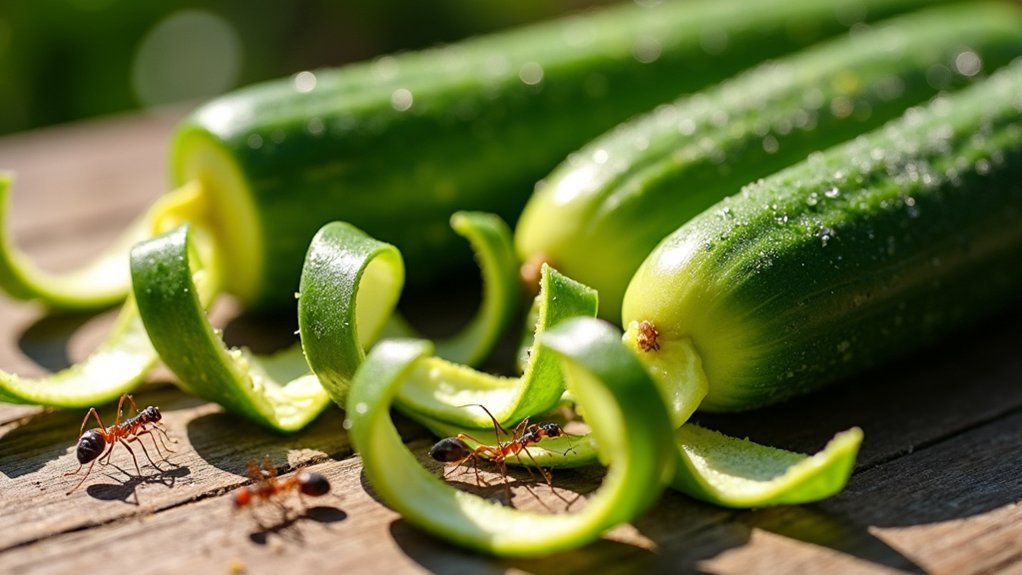
When strategically positioned throughout your home and garden, cucumber peels can effectively deter ant invasions and disrupt their normal foraging patterns.
Place the peels near entry points such as doorways, windows, and small cracks where ants typically enter your home. This creates an immediate barrier against intruders.
For outdoor protection, position cucumber shavings directly on ant trails to interfere with their pheromone communication system, confusing the colony and redirecting their movement.
You’ll achieve maximum effectiveness by placing peels in areas where food sources are stored or prepared, including pantries, countertops, and cabinets.
Don’t forget your garden – incorporate peels around potted plants and garden beds to prevent nesting while simultaneously benefiting your plants.
Remember to replace these natural deterrents every few days to maintain their potency.
Combining Cucumber Peels With Other Natural Repellents
You’ll create more powerful ant barriers by layering cucumber peels with other natural deterrents like peppermint oil or citrus peels.
Combining these repellents attacks ants on multiple sensory levels, confusing their navigation systems and making treated areas highly unappealing.
For maximum protection, try mixing cucumber peels with vinegar spray or diatomaceous earth to create stronger solutions that both repel and disrupt ant colonies.
Layering Cucumber Combinations
While cucumber peels alone offer decent ant-repelling properties, combining them with other natural deterrents creates synergistic effects that greatly enhance their effectiveness.
By layering different natural repellents with cucumber peels, you’ll create barriers ants won’t cross and disrupt their pheromone trails more effectively.
Try these powerful combinations:
- Mix cucumber peels with citrus peels to create a toxic environment for ants—the oils in both work together to maximize repellent effects.
- Combine cucumber peels with coffee grounds to confuse ant navigation while creating an aromatic barrier.
- Enhance cucumber peels with peppermint oil for a potent natural repellent that ants absolutely hate.
- Layer cucumber peels with diatomaceous earth for a dual-action approach that both repels and dehydrates persistent ants.
Stronger Repellent Solutions
Although cucumber peels offer a solid foundation for ant control, combining them with other natural ingredients creates considerably more powerful deterrents that ants can’t ignore.
Try pairing cucumber peels with peppermint essential oil to confuse ants and disrupt their pheromone trails more effectively than using cucumber alone.
For maximum effect, create a barrier using cucumber peels mixed with citrus rinds and cinnamon powder around entry points. This natural method not only repels ants but also prevents new colonies from forming.
You’ll find that spraying surfaces with a vinegar-cucumber solution works as both a cleaner and repellent.
For persistent infestations, scatter diatomaceous earth around cucumber peels to create effective ant traps that both repel and dehydrate these persistent pests, offering a two-pronged defense system.
How Long Cucumber Peels Remain Effective Against Ants
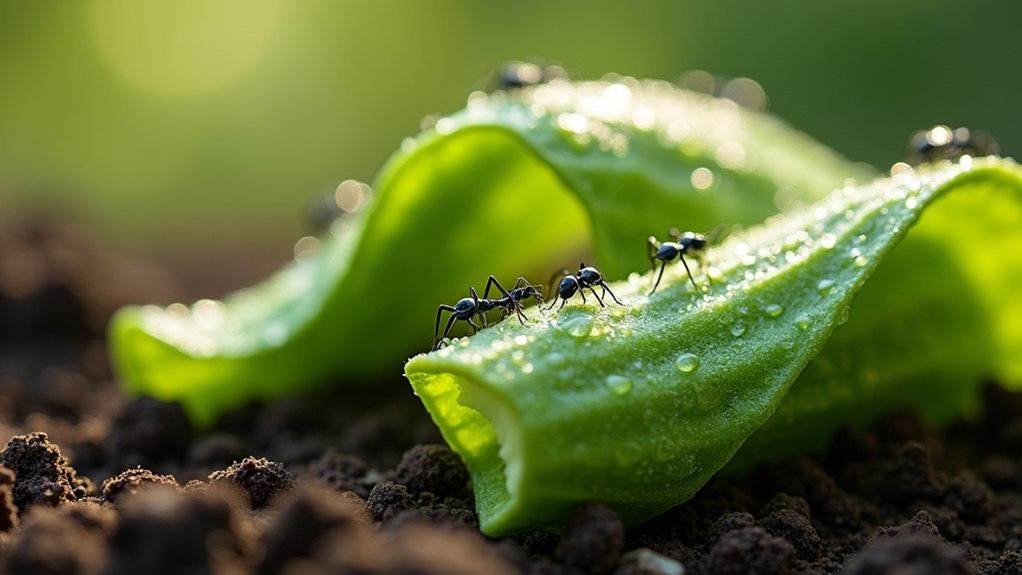
Despite their effectiveness as a natural ant repellent, cucumber peels don’t remain potent indefinitely. The repellent properties diminish over time as the peels lose moisture and their essential oils evaporate.
To maintain their ant-repelling power, you’ll need to:
- Replace cucumber peels every 2-3 days for continued effectiveness
- Watch for signs of drying, as moisture loss considerably reduces their potency
- Understand that repellent oils begin evaporating within the first 24 hours
- Consider combining them with other natural repellents for enhanced protection
You might notice ants gradually returning to areas previously protected by cucumber peels. This happens as the peels lose their potency and as ants potentially adapt to their presence over time.
Types of Ants Most Susceptible to Cucumber Deterrents
Not all ant species respond equally to cucumber peels as a deterrent. You’ll find that household varieties like Argentine and Odorous house ants are particularly vulnerable to cucumber’s scent compounds. Carpenter ants, despite their wood-boring reputation, also retreat when faced with these natural deterrents.
| Ant Species | Susceptibility | Reason |
|---|---|---|
| Argentine/Odorous | High | Sensitive to cucumber compounds |
| Carpenter | Medium-High | Avoids chemical compounds in peels |
| Sugar | High | Disrupted foraging behavior |
The Australian sugar ant shows remarkable aversion to cucumber peels, completely altering their normal foraging behavior when encountered. Pavement ants rely heavily on pheromone trails, which cucumber effectively masks, confusing their navigation. Some research even suggests cucumber compounds break down certain ants’ exoskeletons, making these deterrents particularly effective against multiple species.
Seasonal Considerations for Cucumber Peel Application
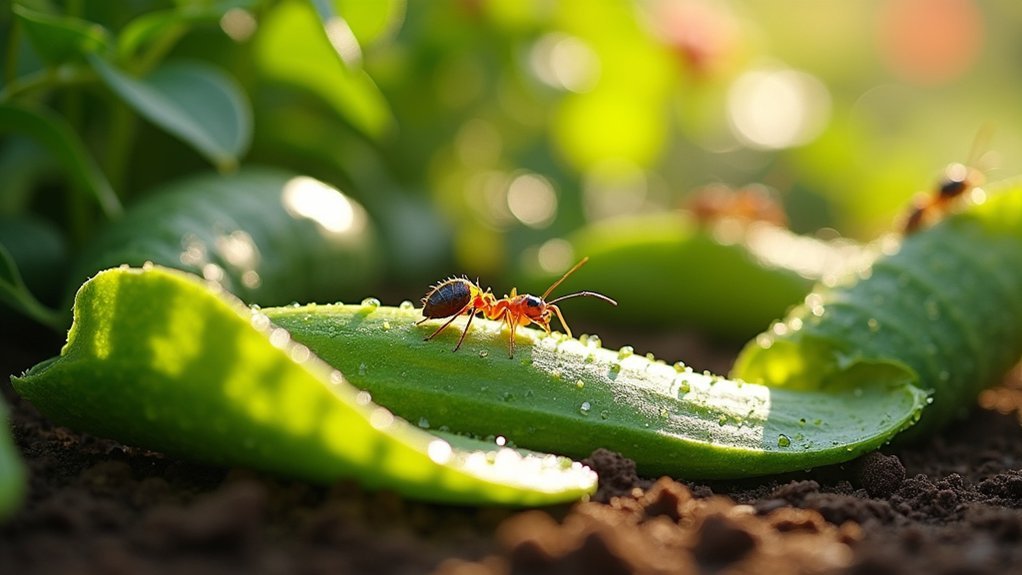
When planning your ant defense strategy, timing plays a crucial role in maximizing cucumber peels’ effectiveness as a natural deterrent. Late spring and summer offer ideal conditions when ant activity peaks due to warmer weather.
For best results throughout the seasons:
- Apply cucumber peels during early morning or late evening when ant activity is highest.
- Focus placement around entry points and known ant trails to create effective barriers.
- Replace peels every few days to maintain their repellent properties, especially after rainfall.
- Combine seasonal cleaning of outdoor areas with cucumber applications to prevent infestations.
Remember that consistent application matters most during warmer months. Your diligence in maintaining fresh peels will provide continuous protection when ants are most persistent and numerous.
Real Homeowner Success Stories With Cucumber Peels
Thousands of homeowners across the country have discovered the surprising effectiveness of cucumber peels as an ant deterrent. Forum posts reveal consistent success when placing fresh peels at entry points, with many reporting significant reduction in ant activity within days of implementation.
“The cucumber peels completely disrupted the pheromone trails the ants were following into my kitchen,” shares one homeowner. “I haven’t seen a single ant since I started using them last month.”
Unlike chemical alternatives, these natural repellents create a safer environment for families with children and pets.
Homeowner success stories consistently highlight that fresh peels outperform dried ones, maintaining their potency for several days before requiring replacement.
You’ll appreciate this eco-friendly solution that effectively confuses ants without introducing toxins into your home.
Comparing Cucumber Peels to Other Food-Based Ant Repellents
While cucumber peels disrupt ants’ exoskeletons through cucurbitacin compounds, citrus peels rely on oils that lose effectiveness in humid conditions.
You’ll find bitter cucumber varieties particularly potent against ants compared to the common sugar-Borax mixtures that require ingestion to work.
Unlike citrus-based deterrents that need replacement more frequently, cucumber peels maintain their repelling properties longer under various environmental conditions.
Cucumber vs. Citrus Effectiveness
Although both serve as natural ant deterrents, cucumber and citrus peels work through distinctly different mechanisms in repelling these persistent pests.
When comparing cucumber to citrus peels, you’ll find important differences in their effectiveness:
- Cucumber peels contain cucurbitacin, a toxic compound that naturally repels ants without harming pets or children.
- Citrus peels release essential oils that disrupt pheromone trails, making it harder for ants to communicate.
- While cucumber offers steady repellent properties, citrus peels work more aggressively by breaking down ant exoskeletons.
- Combining both repellents may provide superior protection—cucumber toxicity keeps ants away while citrus oils destroy their navigation systems.
For maximum effectiveness, consider using both cucumber and citrus peels strategically throughout your home.
Borax-Sugar Mixture Comparison
When comparing cucumber peels to other food-based ant repellents, the borax-sugar mixture stands out as fundamentally different in its approach to pest control.
While cucumber peels repel ants immediately through compounds like cucurbitacin that disrupt their communication pathways, the borax-sugar mixture works as a poison bait system.
You’ll find cucumber peels offer a non-toxic, child-safe solution that drives ants away quickly through scent alone. In contrast, the borax-sugar mixture attracts ants first, then slowly kills them after they carry it back to their colony.
This makes borax effective for larger infestations but requires careful placement away from pets and children.
For quick results with minimal risk, cucumber peels provide an eco-friendly defense. However, if you’re dealing with a persistent colony, the borax method delivers more permanent results despite taking longer to work.
Frequently Asked Questions
Do Cucumbers Keep Ants Away?
Yes, cucumber peels will keep ants away from your home. They contain compounds that are toxic to ants and have a scent they hate. You’ll need to replace them regularly for effectiveness.
What Do Cucumber Peels Repel?
Cucumber peels primarily repel ants. You’ll find they’re effective because they contain cucurbitacin, a compound toxic to ants. They also deter some other insects due to their strong scent that’s unappealing to pests.
What Smell Do Ants Hate the Most?
Ants hate citrus smells the most. You’ll find they’ll quickly avoid areas with lemon or orange peels. They’re also strongly repelled by peppermint, vinegar, and cloves that disrupt their scent trails.
What Do Ants Fear the Most?
Ants fear diatomaceous earth most as it physically destroys their exoskeletons, causing dehydration and death. You’ll find they’re also terrified of strong scents like peppermint oil that obliterate their communication trails.
In Summary
You’ve now discovered how cucumber peels offer a simple, non-toxic solution to your ant problems. They’re easy to implement, environmentally friendly, and cost nothing extra if you’re already buying cucumbers. Next time ants invade your home, don’t reach for harsh chemicals—try cucumber peels first. With proper placement and consistent application, you’ll likely see those pesky invaders retreat within days.

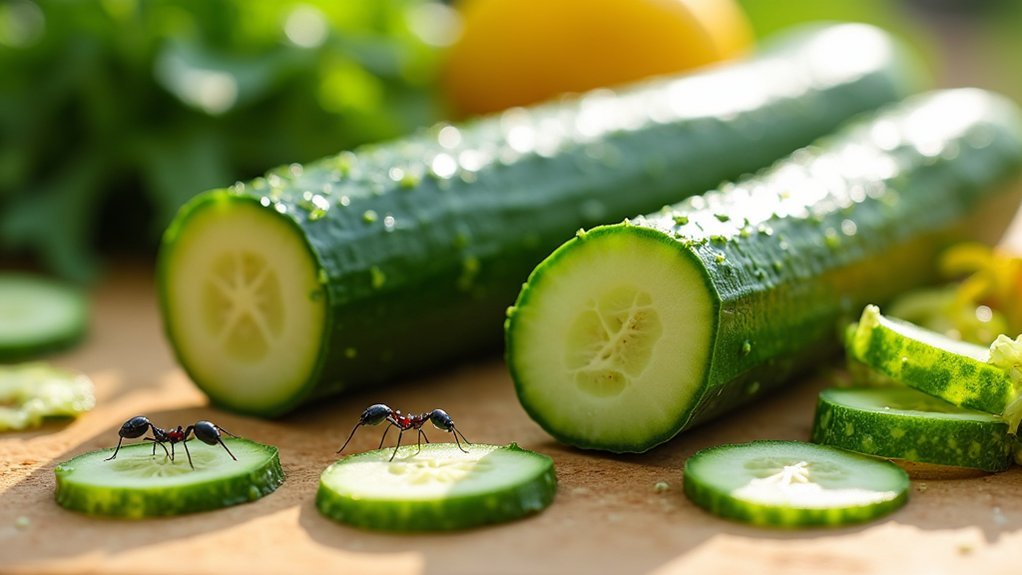



Leave a Reply